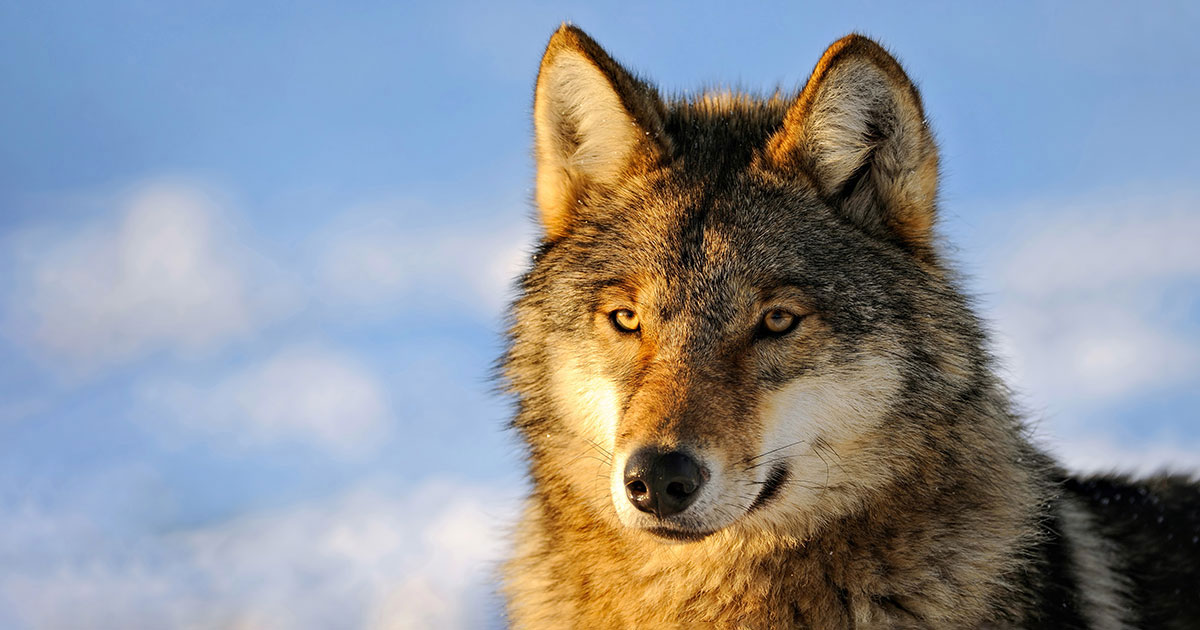
Oct. 20, 2021 – The de-listing of the gray wolf under the Endangered Species Act and the hunting season that decision triggered in Wisconsin have spurred another lawsuit.
On Oct. 1, six Wisconsin Indian Tribes sued the state in the U.S. District Court for the Western District of Wisconsin, seeking an injunction and claiming that the upcoming wolf hunting season violates their treaty rights.
In January, environmental groups filed a federal lawsuit against the U.S. Fish and Wildlife Service (FWS) in California. The lawsuit seeks to reverse the agency’s decision to nationally de-list the gray wolf.
The lawsuit asserts that in making the national de-listing decision, FWS improperly looked only at the Midwest’s wolf population and failed to consider both the loss of habitat in the Rocky Mountains and New England and the role that the Pacific Northwest wolf population plays in the nationwide health of the species.
The lawsuit also claims that FWS failed to use the best science in assessing the stability and habitat of the wolf population in the lower 48 states, and failed to consider how states manage or would manage wolves. Nine states have classified wolves as game animals.
In August, a group of wildlife organizations filed a lawsuit against the State of Wisconsin in Dane County Circuit Court. The suit claims the quota of 300 that the Natural Resources Board (NRB) set for the upcoming wolf hunt is invalid because Fred Prehn, the chairman of the board, holds his position illegally.
Prehn, a holdover who was appointed by former Gov. Scott Walker, cast the deciding vote in favor of the 300 quota.
De-listing Triggered Hunt
The operation of a state statue enacted in 2011, Wis. Stat. section 29.185, triggered the implementation of a Wisconsin wolf hunt. The statute mandates an annual wolf hunt season from November to February if the federal government ever de-lists the gray wolf.
 Jeff M. Brown is a legal writer for the State Bar of Wisconsin, Madison. He can be reached by email or by phone at (608) 250-6126.
Jeff M. Brown is a legal writer for the State Bar of Wisconsin, Madison. He can be reached by email or by phone at (608) 250-6126.
In October 2020, FWS announced that it had decided to de-list the gray wolf. The Wisconsin Department of Natural Resources (DNR) said it would wait until November of 2021 to schedule a hunting season. The agency wanted enough time to set a hunting quota based on science and to collaborate with tribes and the public to create a wolf management plan.
After FWS de-listed the gray wolf in January, a group of legislators asked the NRB to schedule a wolf hunting season for January and February. The board denied that request.
In February, a hunter advocacy group filed a lawsuit in Jefferson County, asking a judge to order the DNR to hold a wolf hunt. Wildlife advocates sided with the DNR and said that it would be unwise to schedule a hunt in February because that month falls in the middle of the species’ breeding season. But the judge ordered the DNR to schedule the hunt.
The DNR scheduled a six-day season and set a quota of 119. But the agency found it difficult to manage the 1,547 hunting permits issued for the hunt and closed the season after only four days because hunters and trappers had killed 216 wolves.
Clash of Cultures
For villagers in pre-industrial Europe, ravening wolves were more than just a New Testament metaphor – they were a recurring threat.
The folklore of Russia and Germany abounds with tales of villagers tossing babies or newlywed couples (depending on the tale) out of sleighs to slow pursuing wolf packs.[1]
European settlers carried memories of those tales with them to North America. They engaged in widespread poisoning, trapping and shooting of wolves – often encouraged by government bounties – and eliminated the species from 95 percent of its habitat in the continental U.S.[2]
Among American Indians, however, the wolf is regarded as a sacred animal that symbolizes bravery, strength, and loyalty. Revered for its hunting prowess, the wolf plays a large role in the religions and cosmographies of many tribes.[3]
According to the DNR, the wolf population in Wisconsin grew from 25 in 1980 to 1,195 in 2020. The DNR has a goal of reducing that population to 350.
Bad Data; Overkill
In 1837 and 1842, the six tribes who filed the most recent lawsuit signed treaties with the federal government. According to court documents, under those treaties the tribes ceded territory to the federal government but retained a half-share in almost all of the natural resources located in the territories.
In their lawsuit, the tribes claim that the state violated their rights in that half-share with regard to the February wolf season in three ways.
First, the tribes assert that the NRB deliberately set the quota of 300 to enable non-tribal members to claim the tribe’s share of the number of harvestable wolves in the state.
After the February hunt, the DNR recommended setting the quota for the 2021-2022 wolf at hunt 130 – 65 for the tribes and 65 for non-tribal hunters.
But the NRB members named in the complaint assumed that the tribes would not kill their share of the quota, the complaint alleges. So, they set the quota at 300 so that non-tribal members could kill 150 wolves, which amounts to more than the sum of the tribal and non-tribal share of the quota recommended by the DNR.
The tribes also assert that the state violated the tribes’ treaty rights by basing the recommended quota of 130 on incomplete wolf population data.
The tribes argue that if incomplete data was used in recommending a quota of 130, there is no assurance that half of 130 accurately represents the share of wolves to which they’re entitled.
According to the complaint, federal court precedent requires that the state must use a “reliable population estimate” in establishing a quota for share of natural resources that the tribes are entitled to under the treaties.
The tribes’ third argument turns upon the overkill that marred the February hunt. The tribes allege that the features of the February hunt that led to overkill – hunting with dogs, assigning 20 licenses per wolf, and a state law that prohibits the DNR from closing a wolf zone without 24-hour public notice – remain in place for this season’s hunt.
“Put simply, tribal treaty rights to hunting, fishing, and gathering require the state to ensure that the underlying resources remain available,” the complaint reads. “A state cannot decimate a resource or pre-determine how a tribe may use its share.”
Endnotes
[1] Paul Schach, Russian Wolves in Folktales and Literature of the Plains, Great Plains Quarterly, Vol. 3, No. 2, Spring 1983, pp. 67-78.
[2] 68 Fed. Reg. 15,804, 15,805 (Apr. 1, 2003); U.S. Fish and Wildlife Service, Gray Wolf, March 2003, at 1 (“Gray Wolf Bio”).
[3] Native Languages of the Americas, Native American Wolf Mythology (last visited Oct. 14, 2021).
